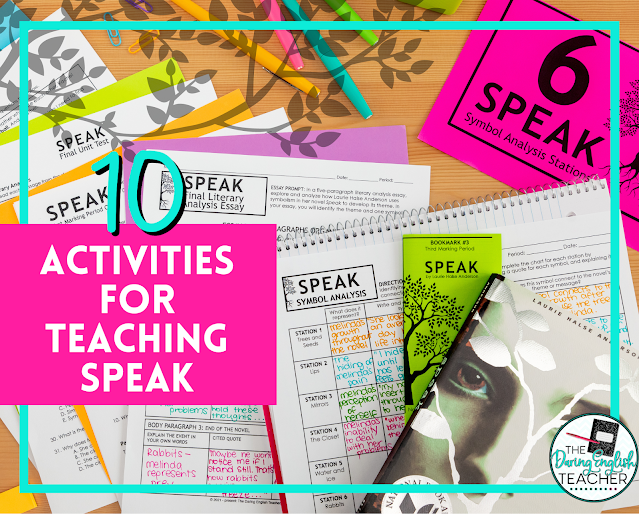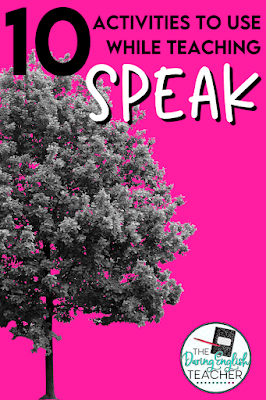Speak is one of those powerful reads that, unfortunately, many students relate to. If not from personal experiences mirroring the main character, the reality of dealing with trauma and the fallout of PTSD, depression, and other ostracizing events. Teaching Speak, though, can be a challenging task. It becomes a deeply personal and empathetic read, so I make an effort to include it in my reading list throughout the year. Read on for activities and ideas to try in your own classroom.
10 Activities to Use when Teaching Speak
1. Bookmark Analysis 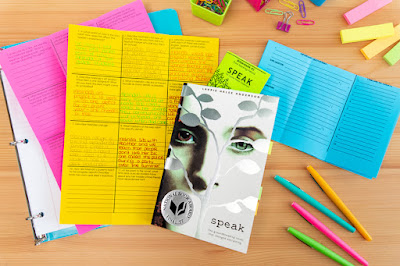
No one thinks about bookmarks. Make use of the usual strips of paper or bits of wrapper that are typically used and give students analysis bookmarks instead. Students will be able to participate in engaging analysis components as they read the novel. It’s fewer worksheets to print out, requires students to jot notes, and is easily accessible right in the book as they read. This bookmark idea is versatile, you can create whatever style and questions or requirements you’d like. If you’re not interested in starting from scratch, I have a novel analysis bookmark created for the Speak novel here.
2. Symbolism Stations 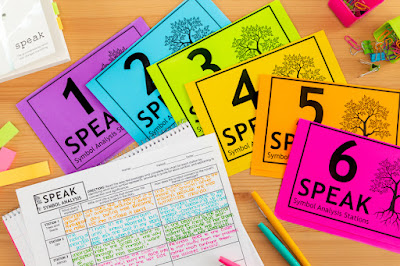
If you’re looking to spice up activities you’ve already created, why not rework them into stations? It gets students up and moving, and they can work collaboratively; you can also forgo worksheets and have students work on graffiti paper or whiteboards. I have a complete symbolism station activity already created for the novel here. It includes six stations, each focusing on a different symbol.
3. Sticky Note Activities 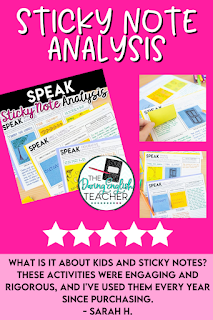
Use your typical office supplies to spin your analysis work differently. One benefit of using sticky notes is they are compact, leaving little space for students. It’s a great option for students to practice their note-taking and summarizing skills. They will have to think critically about what they will want to note or draw to get the information gathered. I have an extensive literary analysis organizer resource that includes 11 sticky note organizers (6 even include built-in writing prompts). Even if these organizers aren’t your cup of tea, consider using sticky notes for note-taking. You can color-code areas of analysis, or students can leave their notes stuck in the book for quick reference. Students can take their sticky notes and reorganize them before writing an essay to keep their thoughts in order.
4. Socratic Seminar
This is an activity of open-ended discussion questions based on the text. Socratic seminars are a wonderful way to introduce students to formal discussions and critical thinking. It also requires articulating their thoughts and responses to others – a challenge if students are used to just writing essays. I think these seminars generate amazing classroom discussions and develop students’ listening, speaking, and critical-thinking skills. If you need help putting together an engaging alternative to your essays, you can find my Socratic Seminar Activity which was created to use with any fictional text.
5. Understanding Character
Students can develop many connections with the text if they take the time to understand the characters. With a novel like Speak, you will have students that can relate to Melinda more than others. Optimize student connections by helping students with character analysis. I have a digital interactive notebook set up for any novel that includes character analysis. You can pick and choose what fits best with your novel (I like the tracing of characters and social media pages for this novel in particular) and use it in print or as a digital resource.
6. Digital Notebook
If you love the digital notebook idea, expand that into the whole novel. I have really enjoyed converting my paper resources into SMARTePlans that are digital, Google-based, and interactive. It’s perfect for technology-driven classrooms. You can find my customizable digital interactive notebook here which is full of literary devices, creative writing assignments, story analysis assignments, and much more. We are living in a digital age, and students need to be able to navigate safely and confidently. We also still have students working remotely, on a hybrid schedule, or working from laptops for most of their work. Also, I save so much time by not standing at the copying machine.
7. Story Cube
Check out my free story cube resource that can be used with any novel. This engages a student’s creative side by having them create a visual representation of each of the story cube’s elements after reading the novel. It reinforces literary elements while also providing differentiation. And as much as I love technology, It’s nice to get students away from their computers and give them an assignment different from what they usually do.
8. Artistic Activities
Along that same idea, art plays an important part to the storyline of Speak. There are several ways you can work the idea of artistic expression into your study. Find artistic works that convey emotional responses to view before reading and discuss how art makes us feel. Better yet, have students research art pieces in various forms and mediums and create a presentation or group assignment where they share their favorites or assign a feeling to research. If you are so inclined, you might consider offering students the opportunity to create their own works of art as well, accompanied by an explanation of their work and inspiration. This is a perfect novel to really bring in the artistic side of things.
9. Classic Essays
There’s always a place for essays and improving writing skills. When I want students to focus on writing, I like them to select one or two goals they will then focus on during the essay assignment. If you have student conferences or peer editing, we will then focus on those areas of improvement before the final essay is turned in. I have found that as far as writing goals go, students feel better equipped when they take on a couple of goals at a time rather than the entirety of “write an essay”. Be sure to take a look at this final literary analysis essay resource, complete with a writing prompt, outline and brainstorming organizers, peer editing and grading rubric. It’s as simple as print and go.
10. Other Art
Art takes on many forms, and the expressions and feelings we can convey through art when we don’t always have the means or energy to express it in conversation is a prominent themes in Speak. This is a great novel to include poetry, particularly contemporary poetry forms. Try setting up an independent study of spoken poetry or contemporary poets where students can explore a variety of poets. You can have them write a paper, research styles, select their favorites, write a book report, complete a poem analysis, or think more creatively and create their own collection. This novel really lends itself to exploring creative expression.
Looking for a whole bundle of goodies you can use for the entire novel? I have an entire unit for Speak available here. It includes bookmarks, analysis stations, quizzes, tests, and essays.
What powerful reads do you like to incorporate into your classroom? Let me know what has been worth adding to your curriculum and class library.

